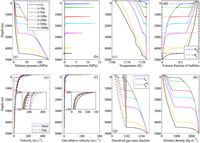Transient numerical model of magma ascent dynamics: application to the explosive eruptions at the Soufrière Hills Volcano
La Spina G., M. de’ Michieli Vitturi, A.B. Clarke (2017).
Journal of Volcanology and Geothermal Research, 336, 118–139, https://doi.org/10.1016/j.jvolgeores.2017.02.013.
Abstract
Volcanic activity exhibits a wide range of eruption styles, from relatively slow effusive eruptions that produce lava flows and lava domes, to explosive eruptions that can inject large volumes of fragmented magma and volcanic gases high into the atmosphere. Although controls on eruption style and scale are not fully understood, previous research suggests that the dynamics of magma ascent in the shallow subsurface (< 10 km depth) may in part control the transition from effusive to explosive eruption and variations in eruption style and scale. Here we investigate the initial stages of explosive eruptions using a 1D transient model for magma ascent through a conduit based on the theory of the thermodynamically compatible systems. The model is novel in that it implements finite rates of volatile exsolution and velocity and pressure relaxation between the phases. We validate the model against a simple two-phase Riemann problem, the Air-Water Shock Tube problem, which contains strong shock and rarefaction waves. We then use the model to explore the role of the aforementioned finite rates in controlling eruption style and duration, within the context of two types of eruptions at the Soufrière Hills Volcano, Montserrat: Vulcanian and sub-Plinian eruptions. Exsolution, pressure, and velocity relaxation rates all appear to exert important controls on eruption duration. More significantly, however, a single finite exsolution rate characteristic of the Soufrière Hills magma composition is able to produce both end-member eruption durations observed in nature. The duration therefore appears to be largely controlled by the timescales available for exsolution, which depend on dynamic processes such as ascent rate and fragmentation wave speed.
http://www.sciencedirect.com/science/article/pii/S0377027316303237


